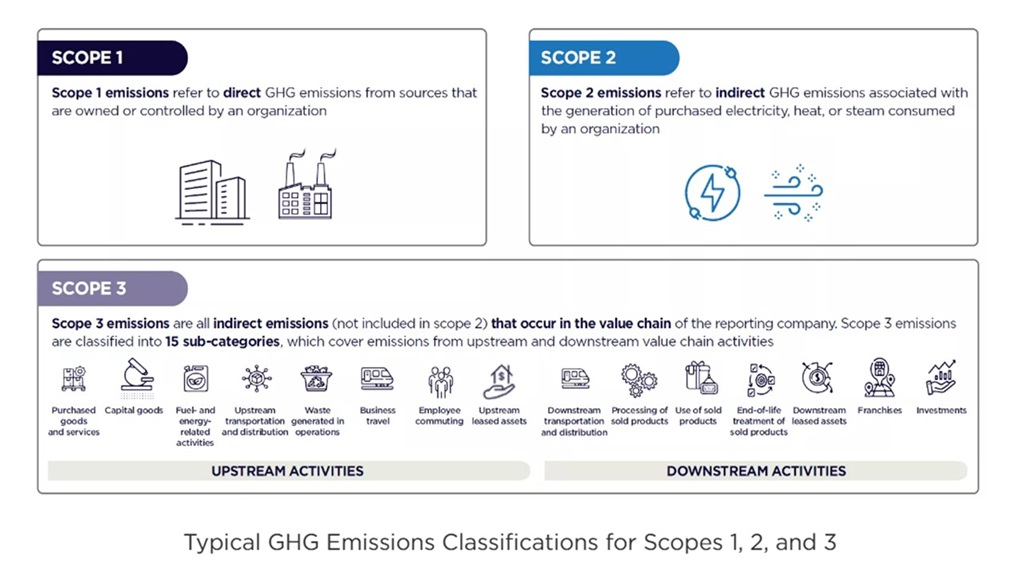One of the biggest drivers for establishing the Semiconductor Climate Consortium (SCC) in 2022 was the need for alignment in greenhouse gas (GHG) emissions calculations across the semiconductor supply chain. The SCC has released its first alignment document with recommendations for calculating Scope 3 Category 1 (Purchased Goods and Services) – a substantial portion of Scope 3 emissions for most companies.
The new guidelines are available for download and build on existing accounting frameworks to provide sector-specific clarity, support, and guidance.
With these guidelines in place, value chain members can quickly determine how to account for and transparently report Scope 3 Category 1 emissions. For smaller companies unable to dedicate resources to studying and implementing various accounting methodologies for different customers, the guidelines should streamline their work.
GHG emissions reporting involves calculating direct emissions (Scope 1), indirect emissions associated with purchased electricity, steam, and heat/cooling (Scope 2), and other indirect emissions from across the value chain (Scope 3), often depicted in Figure 1. Scope 3 Category 1 includes all purchased goods and services across the upstream supply chain, from raw materials onward.

Credit: SEMI
The complexity of the semiconductor value chain required identifying the best approach for all companies to adopt. To help the SCC develop the guidelines, the Consortium commissioned global management consultancy Arthur D. Little (ADL) to conduct the research and analysis, including extensive interviews, and develop the recommendations that now serve as the guidelines. ADL completed its work under the guidance of the SCC Scope 3 Emissions Working Group. The guidelines cover accounting methodologies, boundaries, quantification, calculation methods, and how to select data material for the calculations. The Working Group expects to refine the guidelines as Consortium members gain experience in applying them to their own GHG emissions calculations.
The guidelines include an extensive, industry-specific case study conducted by ADL with SCREEN Semiconductor Solutions. The case study illustrates an approach to identifying hotspots and priority focus areas for Scope 3 Category 1 emissions through a life cycle analysis. Key challenges identified by SCREEN included accounting for a large number of parts per tool, obtaining primary data for the many parts and chemical solutions, and conducting life cycle calculations equipment models where shipments are only a few units per year. The example is helpful for many SCC member companies facing similar challenges in their own emissions calculations."Developing the Category 1 guidance was a complex undertaking that required immense teamwork to accomplish efficiently and effectively," said Elena Kocherovsky, Senior Climate Program Manager at Applied Materials and co-leader of the SCC Scope 3 Emissions Working Group. "A tremendous amount of effort went into collecting best practices from within our industry, and from other industries, and translating findings and recommendations into this comprehensive report. We recognize that this version is a starting point. We look forward to gathering feedback and making improvements as companies begin to apply these practices in their own calculations."
"While companies are implementing the new Scope 3 Category 1 guidelines, our Working Group will be starting on the next steps to develop guidance for calculating and reporting Scope 3 Category 11 (Use of Sold Products)," said Natasha Hodas, a Program Manager with the Supply Chain Responsibility Environmental Team at Intel and co-leader of the SCC Scope 3 Emissions Working Group. "Over the next year, we'll also focus on identifying priority focus areas for Scope 3 Category 1 emissions reductions."
Hodas added, "Doing this work as a team made up of companies from across the world has been illuminating. The collective input and effort from members from across the semiconductor value chain is invaluable to making this effort successful."
"I would especially like to thank SCREEN for contributing the real-life example, which showcases the complexity of the semiconductor ecosystem and the challenges of calculating this very useful emissions calculation," said Mousumi Bhat, Vice President of SEMI Sustainability Programs. "Natasha and Elena and the whole working group came together to produce this critical guideline. While we celebrate this release, we look forward to all of the other ways the SCC and SEMI can assist the industry on important sustainability topics."
Learn more about the Semiconductor Climate Consortium.



